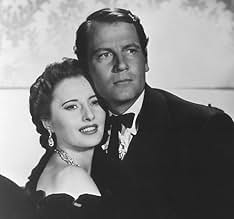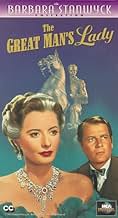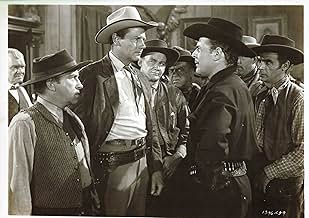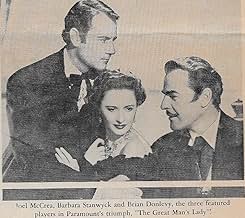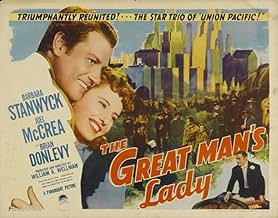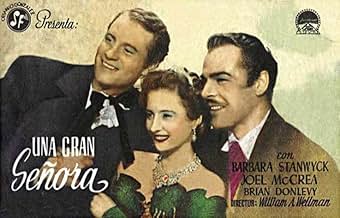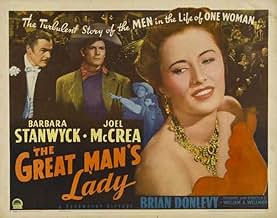Füge eine Handlung in deiner Sprache hinzuA 100-year-old pioneer woman tells her story in flashbacks.A 100-year-old pioneer woman tells her story in flashbacks.A 100-year-old pioneer woman tells her story in flashbacks.
- Auszeichnungen
- 2 wins total
K.T. Stevens
- Girl Biographer
- (as Katharine Stevens)
Irving Bacon
- Parson
- (Nicht genannt)
Hank Bell
- Man #1 - Hoyt City
- (Nicht genannt)
Monte Blue
- Man #2 - Hoyt City
- (Nicht genannt)
Empfohlene Bewertungen
Unfortunately I found this VHS at Video Vault and took it home. All I can say is that even with William A. Wellman directing, Joel McCrea and Barbara Stanwyck acting, Victor Young doing the music and Edith Head the costumes --- each of these people have made pictures ten times better.
Walt Disney's Thumper taught me years ago, "If you can't say nuthin' nice, don't say nuthin' at all." Therefore, I'll note that Great Man's Lady was better than "Shawshank Redemption" which ranks #2 of all time on this website, better than "Order of the Phoenix" whereby Warner's tossed the 750 page story and made a 2 1/2 hour movie with NO story. Please see Wellman's AAA+ "Little Caesar" or McCrea's "4 Faces West" and skip this one.
Walt Disney's Thumper taught me years ago, "If you can't say nuthin' nice, don't say nuthin' at all." Therefore, I'll note that Great Man's Lady was better than "Shawshank Redemption" which ranks #2 of all time on this website, better than "Order of the Phoenix" whereby Warner's tossed the 750 page story and made a 2 1/2 hour movie with NO story. Please see Wellman's AAA+ "Little Caesar" or McCrea's "4 Faces West" and skip this one.
Unfortunately, whatever production values this film contains are generally spoiled by the passage of time and fortunate changes in perspective. For those of us watching now are happily forewarned in the narrator's introduction to the film in which it is not only explicit as to the woman character's subordinate position to her "great man" but also at least implicit as to the role of any woman in the life of her "great man." Of the many "flash-back" films where the character re-hashes their past, this is certainly melodramatic in its acting and characterizations. The action does not seem compelling to watch, as if one could fast-forward to get to the punch line, which does not really satisfy - the principal male character's life is summed up in such high regard as to make one wonder if the viewer had just seen the same film! One has to wonder how female audience members felt about the general message (such as it is) of this film when it opened in theatres, although Ms. Stanwyck most likely held her own in her stubbornness by standards of the time.
10SHAWFAN
Such undeserved condescension on the part of most of your reviewers! I thought it was an absorbing romantic drama in which Stanwyck was at her very best. As she turned from youthful sparkly-eyed amused flirt in her first scenes with McCrea into the mature more gray-haired woman seriously urging him to do his political best for those whom he represented, her virtuosity as an actress of transformations came greatly to the fore. It was a pleasure to respond to her in her various moods of youthful love, a stunned mother's loss of her two babies, her vigorous denunciation of her father in his unconscionable request of her, and finally the resignation of old age in which she at last destroys the long-lived marriage certificate she's been carrying around through most of the story.
McCrea was also very good, especially in the scene in which he confesses himself guilty of the same kind of corruption so rife in the American West at that railroad-building time.
The story seemed to echo the true events of The Ballad of Baby Doe (opera) in its background of silver mining and marital troubles; and it certainly resembled Edna Ferber-Abby Mann's Cimarron in retelling the story of a marriage in which the husband spends years on the road away from his wife.
The 19th-century flooding in Sacramento was certainly up to date given the similar events happening in that city in our own times as well.
A great movie. Pay no attention to those detractors.
McCrea was also very good, especially in the scene in which he confesses himself guilty of the same kind of corruption so rife in the American West at that railroad-building time.
The story seemed to echo the true events of The Ballad of Baby Doe (opera) in its background of silver mining and marital troubles; and it certainly resembled Edna Ferber-Abby Mann's Cimarron in retelling the story of a marriage in which the husband spends years on the road away from his wife.
The 19th-century flooding in Sacramento was certainly up to date given the similar events happening in that city in our own times as well.
A great movie. Pay no attention to those detractors.
Joel McCrea and Barbara Stanwyck made six films together, the most they did respectively with other leads. The Great Man's Lady while not the best example of their joint work is certainly one interesting if somewhat incredible film.
I can certainly see what attracted Stanwyck to a role that was part Maytime and part any number of Edna Ferber like tales of empire builders. Stanwyck is certainly a better actress than Jeanette MacDonald and she really does carry off the part of the 107 year old pioneer woman who is telling a young reporter about her most interesting life.
Like in Cimarron, McCrea and Stanwyck start out for the west in the 1840s in search of opportunity and like in Cimarron the woman is being taken from a life of ease and comfort to become a pioneer. The film shows how very useful she was to him.
Albeit even with her conservative politics in real life, Stanwyck was a feminist icon and in the 19th century without even the right to vote, women held a far different position than they do legally now. What help she renders to McCrea is on the unofficial side. But as the story unfolds she contributes mightily to his rise to fame and power and sacrifices EVERYTHING for him.
I'd like to give the film a higher rating, but the thing that totally throws me is the part her father plays in her ultimate decision. Thurston Hall is Stanwyck's father and he's a typical robber baron of the era. But I can't see any father asking his daughter to do what she did for business reasons. It makes the whole story quite bizarre.
McCrea and Stanwyck liked each other personally and professionally. In Tony Thomas's book about Joel McCrea based on interviews he did with him in the Eighties, McCrea said that Barbara Stanwyck was his favorite leading lady. She was thoroughly professional and helpful to every other cast member in any film she was in. He had no qualms in saying that The Great Man's Lady is her film all the way.
It's far from her best film, but for Barbara Stanwyck fans it's one of her best performances.
I can certainly see what attracted Stanwyck to a role that was part Maytime and part any number of Edna Ferber like tales of empire builders. Stanwyck is certainly a better actress than Jeanette MacDonald and she really does carry off the part of the 107 year old pioneer woman who is telling a young reporter about her most interesting life.
Like in Cimarron, McCrea and Stanwyck start out for the west in the 1840s in search of opportunity and like in Cimarron the woman is being taken from a life of ease and comfort to become a pioneer. The film shows how very useful she was to him.
Albeit even with her conservative politics in real life, Stanwyck was a feminist icon and in the 19th century without even the right to vote, women held a far different position than they do legally now. What help she renders to McCrea is on the unofficial side. But as the story unfolds she contributes mightily to his rise to fame and power and sacrifices EVERYTHING for him.
I'd like to give the film a higher rating, but the thing that totally throws me is the part her father plays in her ultimate decision. Thurston Hall is Stanwyck's father and he's a typical robber baron of the era. But I can't see any father asking his daughter to do what she did for business reasons. It makes the whole story quite bizarre.
McCrea and Stanwyck liked each other personally and professionally. In Tony Thomas's book about Joel McCrea based on interviews he did with him in the Eighties, McCrea said that Barbara Stanwyck was his favorite leading lady. She was thoroughly professional and helpful to every other cast member in any film she was in. He had no qualms in saying that The Great Man's Lady is her film all the way.
It's far from her best film, but for Barbara Stanwyck fans it's one of her best performances.
When the statue of the founder of Hoyt City, Ethan Hoyt (Joel McCrea) is dedicated, the sensationalist reporters and a biographer (Katharine Stevens) head to the house of the one hundred year-old Hannah Sempler (Barbara Stanwyck), where Ethan died, to know the relationship between them. Ms. Hannah sends them all out but the lady. Then she tells her life since she was a teenager and felt in love with the pioneer Ethan.
In 1848, in Philadelphia, Ethan dreams on building Hoyt City, but he needs financiers and influent people to change the route of the railroad. Hannah decides to leave her upper-class father and marries with Ethan. Eight years later, she meets the gambler Steely Edwards (Brian Donlevy) and they become close friends. When Ethan discovers silver, Steely lends money to Hannah with the condition that she does not go to the mines with Ethan. Along the years, Ethan becomes rich and far from Hannah that he believes had died in a flood. Years later, they meet each other again in Hoyt City but their love is doomed since Ethan has raised a family of his own.
"The Great Man's Lady" is a classic with some of my favorite directors (William A. Wellman), actresses (Barbara Stanwyck) and actors (Joel McCrea and Brian Donlevy); and haunting music score by Victor Young. Unfortunately the story is a confused romance with a not well-explained triangle of love. I did not understand the quote "spring never comes again", since spring returns every year. My vote is six.
Title (Brazil): "Até Que a Morte nos Separe" ("Till Death Do Us Apart")
In 1848, in Philadelphia, Ethan dreams on building Hoyt City, but he needs financiers and influent people to change the route of the railroad. Hannah decides to leave her upper-class father and marries with Ethan. Eight years later, she meets the gambler Steely Edwards (Brian Donlevy) and they become close friends. When Ethan discovers silver, Steely lends money to Hannah with the condition that she does not go to the mines with Ethan. Along the years, Ethan becomes rich and far from Hannah that he believes had died in a flood. Years later, they meet each other again in Hoyt City but their love is doomed since Ethan has raised a family of his own.
"The Great Man's Lady" is a classic with some of my favorite directors (William A. Wellman), actresses (Barbara Stanwyck) and actors (Joel McCrea and Brian Donlevy); and haunting music score by Victor Young. Unfortunately the story is a confused romance with a not well-explained triangle of love. I did not understand the quote "spring never comes again", since spring returns every year. My vote is six.
Title (Brazil): "Até Que a Morte nos Separe" ("Till Death Do Us Apart")
Wusstest du schon
- WissenswertesOne of over 700 Paramount productions, filmed between 1929-49, that were sold to MCA/Universal in 1958 for television distribution, and have been owned and controlled by Universal ever since. Its initial television broadcasts took place in Los Angeles Thursday 8 January 1959 on KNXT (Channel 2) and in St. Louis Friday 9 January 1959 on KMOX (Channel 4). In Seattle, it first aired 24 July 1959 on KIRO (Channel 7), in Phoenix 8 August 1959 on KVAR (Channel 12), in Milwaukee 27 September 1959 on WITI (Channel 6), in Pittsburgh 26 October on KDKA (Channel 2), in Detroit 29 October 1959 on WJBK (Channel 2), in Toledo 19 December 1959 on WTOL (Channel 11), in Omaha 22 December 1959 on KETV (Channel 7), in Grand Rapids 27 December 1959 on WOOD (Channel 8), in Chicago 29 December 1959 on WBBM (Channel 2), in New York City 26 March 1960 on WCBS (Channel 2), in Minneapolis 9 November 1960 on WTCN (Channel 11), in Philadelphia 22 December 1962 on WCAU (Channel 10), and in San Francisco 3 February 1963 on KPIX (Channel 5). It was released on DVD 27 April 2010 as one of six titles in Universal's Barbara Stanwyck Collection and on 13 July 2015 as a single as part of the Universal Vault Series; since that time, it's also enjoyed occasional airings on Turner Classic Movies.
- PatzerWhen the Hoyts stand at the sight of their future city, they're at the foot of a hill, but moments later they're on top of a hill.
- VerbindungenFeatured in Biography: Barbara Stanwyck: Straight Down the Line (1997)
- SoundtracksUnfinished Symphony
("Symphony 8 in B Major") (uncredited)
Composed by Franz Schubert (begun 1822)
Heard on soundtrack during Janet and Ethan's farewell and under end title
Top-Auswahl
Melde dich zum Bewerten an und greife auf die Watchlist für personalisierte Empfehlungen zu.
- How long is The Great Man's Lady?Powered by Alexa
Details
- Laufzeit1 Stunde 30 Minuten
- Farbe
- Seitenverhältnis
- 1.37 : 1
Zu dieser Seite beitragen
Bearbeitung vorschlagen oder fehlenden Inhalt hinzufügen

Oberste Lücke
By what name was The Great Man's Lady (1941) officially released in India in English?
Antwort
